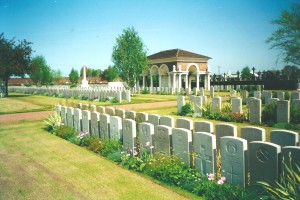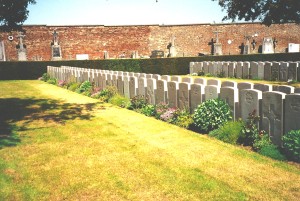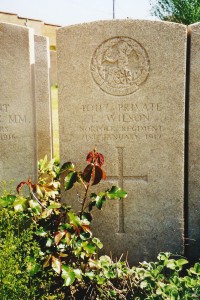In November 1869 William Wilson and Hepzibah Tyrrell from Saxlingham Nethergate were married in the local church. They had eight children all of whom survived. William was a bricklayer and later a builder. The family lived at various addresses in Saxlingham, initially on Pitts Hill and later on the Street between the Prince of Wales and the Bowling Green Public houses.
Frederick was their youngest child born in 1887. He was baptised in St. Mary’s church on 27th April 1887. He had three brothers and four sisters. Arthur was born in 1869, Harriet in 1875 William in 1876, George in 1879, Alice in 1881, Annie in 1883 and Ada in 1885.
In 1901 Frederick was aged 14 years old and was working in the local bakery. Ten years later he was employed as a gardener’s labourer and still living at home with his parents.
He enlisted in Norwich into 9th Battalion Norfolk Regiment. He did not serve in France until 1916 . On 21st October 1916 he was admitted into the 23rd General hospital at Etaples with a gunshot wound to his hand.
In early September the 9th Battalion had been involved in heavy fighting near to Ginchy. They had suffered serious losses with 431 casualties. At the beginning of October the battalion had only a few experienced non-commissioned officers and men left. By 16th October they were again at the Front and on 18th October began an attack on what was known as Mild Trench as part of the Battle of Le Transloy. Conditions were very bad with wet weather which made the mud into a quagmire. It was difficult for the men to climb out over the top of the trenches as they kept slipping. It was also a very dark night which also caused problems with men becoming lost. The objectives were not met but during the battle casualties were again very heavy. The battalion was relieved on 19th October and then went near Bethune for training. Frederick must have received his gunshot wound in this battle but it would have taken him time to be transferred to the General hospital in Etaples. It is not known how long he stayed at the hospital.
The battalion remained in the Bethune region until the end of November when it was briefly attached to the Royal Engineers to help with tunnelling. They then went back into the front line trenches. The conditions during the winter in the trenches were very bad. The men would stand in cold liquid mud when on duty and then have to return to equally muddy dugouts to try and sleep and get warm. Many suffered ill health because of the conditions.
Frederick died on 21st January 1917 at the 33rd General Clearing Station at Bethune from bronchitis and asthma.
He is buried in Bethune Town Cemetery.
Until early 1918 Bethune was an important railway and hospital centre as it was free from enemy bombardment. Men who died in the 33rd Casualty Clearing Station were buried in this cemetery.
Acknowledgements
Census records: 1871, 1881, 1891, 1901, 1911
UK soldiers who died in the Great War 1914-18
Papers from Saxlingham Nethergate Church Chest now deposited at Norfolk Record Office
British Army WW1 Medal Rolls Index Cards 1914-1920
Norfolk Regimental Museum records, Castle Musuem, Norwich
Petre, F. Loraine. The History of the Norfolk Regiment: Jarrold & Sons Ltd Norwich.



